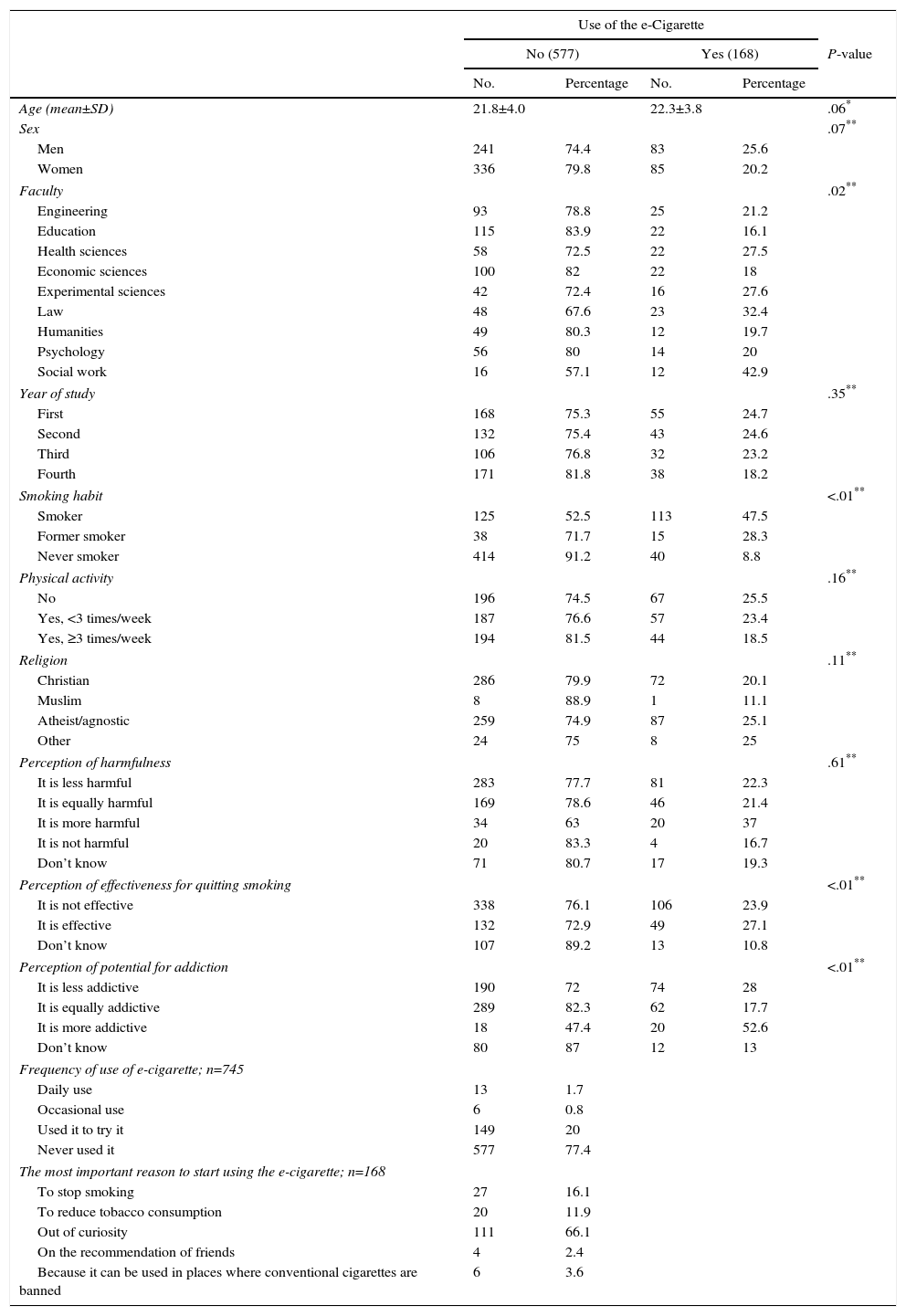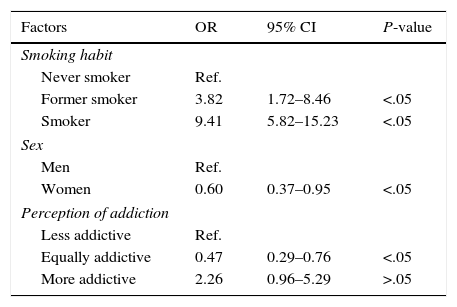The long-term effects of use of electronic cigarettes (e-cigarette) to control smoking has generated both debate and concern in the public health arena.1 The prevalence of this device varies among the various European countries.2 In general, however, it appears to be more widely used by individuals aged between 15 and 24 years,3 and e-cigarette use is positively associated with being a student.4 Nevertheless, little is known about the use of e-cigarettes and how they are perceived among young people in Spain. This study, then, was conducted in this setting, with the aim of determining the perceptions of university students of e-cigarettes and how they use these devices.
This was a cross-sectional study conducted in a reference population of undergraduate students enrolled in the 2015–2016 academic year in the Universidad de Almeria, with a calculated sample size of 373 students. Data were collected using a self-administered online questionnaire consisting of a total of 14 items ranging from sociodemographic variables, smoking habit, physical activity, and awareness, use and perception of the e-cigarette. For study purposes, an invitation to participate with a link to the questionnaire was sent to the emails of the 10897 students enrolled in the university. In total, 771 students answered the questionnaire; 745 of these were correctly completed.
Mean age of respondents was 21.9±3.9 years, 31.9% were smokers, 60.9% were non-smokers, and 7.1% were former smokers. In total, 22.6% of the participants had used an e-cigarette at some time, and 1.7% used it on a daily basis (Table 1). The logistic regression analysis showed that smokers (OR=9.41) and former smokers (OR=3.82) were more likely to use the device than non-smokers (Table 2).
Sociodemographic Characteristics and Perceptions About the e-Cigarette and its Use.
| Use of the e-Cigarette | |||||
|---|---|---|---|---|---|
| No (577) | Yes (168) | P-value | |||
| No. | Percentage | No. | Percentage | ||
| Age (mean±SD) | 21.8±4.0 | 22.3±3.8 | .06* | ||
| Sex | .07** | ||||
| Men | 241 | 74.4 | 83 | 25.6 | |
| Women | 336 | 79.8 | 85 | 20.2 | |
| Faculty | .02** | ||||
| Engineering | 93 | 78.8 | 25 | 21.2 | |
| Education | 115 | 83.9 | 22 | 16.1 | |
| Health sciences | 58 | 72.5 | 22 | 27.5 | |
| Economic sciences | 100 | 82 | 22 | 18 | |
| Experimental sciences | 42 | 72.4 | 16 | 27.6 | |
| Law | 48 | 67.6 | 23 | 32.4 | |
| Humanities | 49 | 80.3 | 12 | 19.7 | |
| Psychology | 56 | 80 | 14 | 20 | |
| Social work | 16 | 57.1 | 12 | 42.9 | |
| Year of study | .35** | ||||
| First | 168 | 75.3 | 55 | 24.7 | |
| Second | 132 | 75.4 | 43 | 24.6 | |
| Third | 106 | 76.8 | 32 | 23.2 | |
| Fourth | 171 | 81.8 | 38 | 18.2 | |
| Smoking habit | <.01** | ||||
| Smoker | 125 | 52.5 | 113 | 47.5 | |
| Former smoker | 38 | 71.7 | 15 | 28.3 | |
| Never smoker | 414 | 91.2 | 40 | 8.8 | |
| Physical activity | .16** | ||||
| No | 196 | 74.5 | 67 | 25.5 | |
| Yes, <3 times/week | 187 | 76.6 | 57 | 23.4 | |
| Yes, ≥3 times/week | 194 | 81.5 | 44 | 18.5 | |
| Religion | .11** | ||||
| Christian | 286 | 79.9 | 72 | 20.1 | |
| Muslim | 8 | 88.9 | 1 | 11.1 | |
| Atheist/agnostic | 259 | 74.9 | 87 | 25.1 | |
| Other | 24 | 75 | 8 | 25 | |
| Perception of harmfulness | .61** | ||||
| It is less harmful | 283 | 77.7 | 81 | 22.3 | |
| It is equally harmful | 169 | 78.6 | 46 | 21.4 | |
| It is more harmful | 34 | 63 | 20 | 37 | |
| It is not harmful | 20 | 83.3 | 4 | 16.7 | |
| Don’t know | 71 | 80.7 | 17 | 19.3 | |
| Perception of effectiveness for quitting smoking | <.01** | ||||
| It is not effective | 338 | 76.1 | 106 | 23.9 | |
| It is effective | 132 | 72.9 | 49 | 27.1 | |
| Don’t know | 107 | 89.2 | 13 | 10.8 | |
| Perception of potential for addiction | <.01** | ||||
| It is less addictive | 190 | 72 | 74 | 28 | |
| It is equally addictive | 289 | 82.3 | 62 | 17.7 | |
| It is more addictive | 18 | 47.4 | 20 | 52.6 | |
| Don’t know | 80 | 87 | 12 | 13 | |
| Frequency of use of e-cigarette; n=745 | |||||
| Daily use | 13 | 1.7 | |||
| Occasional use | 6 | 0.8 | |||
| Used it to try it | 149 | 20 | |||
| Never used it | 577 | 77.4 | |||
| The most important reason to start using the e-cigarette; n=168 | |||||
| To stop smoking | 27 | 16.1 | |||
| To reduce tobacco consumption | 20 | 11.9 | |||
| Out of curiosity | 111 | 66.1 | |||
| On the recommendation of friends | 4 | 2.4 | |||
| Because it can be used in places where conventional cigarettes are banned | 6 | 3.6 | |||
Logistic regression model of factors associated with the use of the e-cigarette.*
| Factors | OR | 95% CI | P-value |
|---|---|---|---|
| Smoking habit | |||
| Never smoker | Ref. | ||
| Former smoker | 3.82 | 1.72–8.46 | <.05 |
| Smoker | 9.41 | 5.82–15.23 | <.05 |
| Sex | |||
| Men | Ref. | ||
| Women | 0.60 | 0.37–0.95 | <.05 |
| Perception of addiction | |||
| Less addictive | Ref. | ||
| Equally addictive | 0.47 | 0.29–0.76 | <.05 |
| More addictive | 2.26 | 0.96–5.29 | >.05 |
Independent variables specified in the model: age, sex (1: male; 2: female); religion (1: Christian; 2: Muslim; 3: atheist/agnostic; 4: other); smoking habit (0: never smoker; 1: former smoker; 2: smoker); physical activity (0: no; 1: yes); perception of harmfulness (0: it is not harmful; 1: it is less harmful; 2: it is equally harmful; 3: it is more harmful); perception of effectiveness for quitting smoking (0: no; 1: yes); perception of addiction (0: less addictive; 1: equally addictive; 2: more addictive).
In our study, most respondents (59.6%) thought that the e-cigarette was not an effective aid for quitting smoking. This coincides with the findings of Valero-Juan and Suárez del Arco,5 and differs from those of Choi and Forster,6 who reported a significant percentage of respondents (44.5%) who thought that the device could help stop smoking. However, advertising for this product which suggested, among other messages, that the device is useful for stopping smoking,7 has been regulated in Spain since 2014. In line with these regulations, it is forbidden to attribute any efficacy to the device that has not been recognized by a competent body.8 The high perception of lack of efficacy of the e-cigarette found in our study may be associated with the regulations imposed on the advertising of these devices.
Our study also shows that most students (47.1%) believe that the e-cigarette is just as addictive as the conventional cigarette. The prevalence of this view may be due, among other factors, to certain features of the e-cigarette, such as its ability to release nicotine and the similarity of its appearance and use to the conventional cigarette. With regard to the perception of harmful effects, most students (48.9%) responded that the e-cigarette is less harmful than the conventional cigarette, in line with the findings of Choi and Forster.6
Most respondents (66.1%) started to use the device out of curiosity. This may be because the marketing techniques of manufacturers of these devices are aimed at making them attractive to young people,9 or because the e-cigarette is perceived to be sophisticated or modern among the young.9 These factors may make individuals curious to use the device or to experience the sensation that it might produce. Biener et al.10 also reported that the most common reason among participants for trying the devices was curiosity, while Tavolacci et al.11 found that the most common reason was to give up smoking.
In our study, most e-cigarette users were smokers (67.3%). This suggests the existence of dual use, i.e. students who use conventional cigarettes along with e-cigarettes.12 This was also reported in other studies.6,12,13 The significant association between the consumption of tobacco and the use of the e-cigarette found in our study is consistent with other studies in students.14,15 The relationship between the use of the e-cigarette and being a former smoker may be due to the fact that former smokers may be attracted by the device, prompting them to resume smoking6 and leading them to try the device or to use it more frequently.
The level of use of the e-cigarette in our study is almost the same as that reported by Tavolacci et al.,11 in which 23% of students used it, and somewhat higher than the 19% reported by Goniewicz and Zielinska-Danch.14 Choi and Forster6 found a level of use of 7%, while Sutfin et al.13 reported that less than 5% of respondents had used it. The high percentage obtained in our study suggests a growing interest in the device among students.
Finally, to conclude, we found that most students believe that the e-cigarette is not effective as a smoking cessation aid, and that it is just as addictive as the conventional cigarette. The most common reason for using the e-cigarette among students is curiosity, and tobacco consumption is related to the use of e-cigarette.
Please cite this article as: Rodriguez E, Parrón T, Alarcón R. Percepciones y uso del cigarrillo electrónico en estudiantes universitarios. Arch Bronconeumol. 2017;53:650–652.











